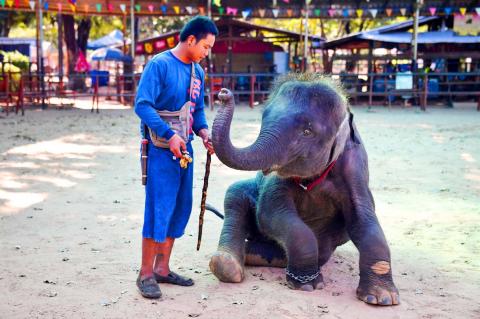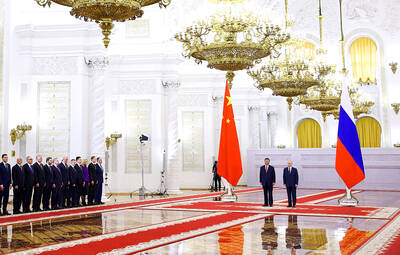Separated from their mothers, jabbed with metal hooks and sometimes deprived of food — many Thai elephants are tamed by force before being sold to lucrative tourism sites increasingly advertised as “sanctuaries” to cruelty-conscious travelers.
Balanced precariously on her hind legs, two-year-old Ploy holds a ball in her trunk and flings it toward a hoop, one of many tricks she is learning in Ban Ta Klang, a traditional training village in the east.
Here young elephants are “broken” to interact with tens of millions of tourists who visit Thailand every year, many eager to capture social media-worthy encounters of the kingdom’s national animal playing sports, dancing and even painting.

Photo: AFP
Villagers in Ban Ta Klang who have been working with the large, gentle animals for generations say taming is necessary for safety reasons and that the force is not excessive.
“We do not raise them to hurt them ... if they are not stubborn, we do nothing to them,” mahout Charin said, as he stroked Ploy’s head affectionately and spoke of her as part of his family.
Charin makes about US$350 a month in a profession that was handed down from his father and grandfather. “I have always lived with them,” he added.
However, animal welfare advocates argue the taming technique — where babies are removed from the care of fiercely devoted mothers at the age of two — is cruel and outdated.
It is also little-known, one of many murky aspects of an evolving elephant tourism trade often kept from view of tour operators and travelers.
Elephants were phased out of the logging industry about 30 years ago, leaving their mahouts unemployed.
So they turned to Thailand’s flourishing tourism industry, a burgeoning sector of amusement parks offering elephant rides and performances.
BIG BUSINESS
A tamed elephant can now fetch up to US$80,000, a colossal investment that then requires grueling hours of work and increasingly bizarre stunts to be recouped.
Mae Taeng park in the northern city of Chiang Mai receives up to 5,000 visitors per day and charges an entrance fee of about US$50.
Many come to see Suda, who holds a brush in her trunk and paints Japanese-style landscapes for visitors who are able to later buy the prints for up to US$150 before taking an elephant ride through the hills.
As tourists become more aware of the potential cruelty of such activities, a growing number of places have opted to use the term “sanctuary” or “refuge.”
Many do not permit rides or animal performances. Instead, tourists are encouraged to feed, groom and care for elephants, gaining an unforgettable experience with one of nature’s most majestic creatures.
ETHICAL TOURISM?
However, charities warn that even seemingly benign options, like bathing them, could still be problematic.
“Bathing with elephants ... is often stressful for elephants and mahouts especially when dealing with groups of excited young people,” Jan Schmidt-Burbach of World Animal Protection (WAP) told reporters.
“The best option is to leave it to the elephant to decide if and how to bath and ask tourists to stand back to observe and enjoy this moment without interference,” he said.
Yet even this might not be enough. Some animal rights experts warn it could be hard to discern the treatment of the animals after the crowds have gone home.
Some have reported cases of elephants at so-called sanctuaries being chained for long hours, forced to sleep on concrete and malnourished.
CHANGING METHODS
Of the 220 elephant parks identified across the country, even if many promise ethical tourism, “only a dozen ensure truly satisfactory living conditions,” WAP said.
It is working with ChangChill, a small organization near Chiang Mai, bordered by a river in the middle of rice terraces. In a few months, it changed its methods to give elephants more space, fewer interactions and an environment resembling life in the wild.
“We don’t force them to do what they wouldn’t instinctively do,” director Supakorn Thanaseth said.
As a result, they are “less sick, calmer.” The risk of accidents with tourists has decreased as the animals are less stressed, though mahouts still have a hook in a bag for emergencies.
ChangChill hopes to become profitable in the current high season, but it would only be able to receive around 40 tourists a day to visit its six elephants as part of its aim to put the creatures first. That is a drop in the bucket considering that Thailand has nearly 4,000 “domesticated” elephants.
Thai authorities are reluctant to reintroduce them into natural habitats, as advocated by some nonprofit organizations, because of a lack of space and potential conflict with humans.
The compromise, some argue, is to better regulate the sector and improve standards.
However, there is little impetus to enact more stringent rules that would cut into the Thai tourism industry, which welcomed more than 38 million visitors this year. A committee of several animal welfare associations submitted recommendations to the government last year advocating for stricter controls for elephants in captivity.
Yet, according to activist Sovaida Salwala from Friends of the Asian Elephants, a nonprofit that helped compile the report, their requests “remain unanswered so far.”
In fact, there is some evidence the animals’ situation is getting worse. Schmidt-Burbach said their last research in 2015 found some 1,771 elephants whose welfare was in question. “There are 357 more elephants in poor conditions compared to our 2010 study,” he said.

A new online voting system aimed at boosting turnout among the Philippines’ millions of overseas workers ahead of Monday’s mid-term elections has been marked by confusion and fears of disenfranchisement. Thousands of overseas Filipino workers have already cast their ballots in the race dominated by a bitter feud between President Ferdinand Marcos Jr and his impeached vice president, Sara Duterte. While official turnout figures are not yet publicly available, data from the Philippine Commission on Elections (COMELEC) showed that at least 134,000 of the 1.22 million registered overseas voters have signed up for the new online system, which opened on April 13. However,

ALLIES: Calling Putin his ‘old friend,’ Xi said Beijing stood alongside Russia ‘in the face of the international counter-current of unilateralism and hegemonic bullying’ Chinese President Xi Jinping (習近平) yesterday was in Moscow for a state visit ahead of the Kremlin’s grand Victory Day celebrations, as Ukraine accused Russia’s army of launching air strikes just hours into a supposed truce. More than 20 foreign leaders were in Russia to attend a vast military parade today marking 80 years since the defeat of Nazi Germany in World War II, taking place three years into Russia’s offensive in Ukraine. Putin ordered troops into Ukraine in February 2022 and has marshaled the memory of Soviet victory against Nazi Germany to justify his campaign and rally society behind the offensive,

ENTERTAINMENT: Rio officials have a history of organizing massive concerts on Copacabana Beach, with Madonna’s show drawing about 1.6 million fans last year Lady Gaga on Saturday night gave a free concert in front of 2 million fans who poured onto Copacabana Beach in Rio de Janeiro for the biggest show of her career. “Tonight, we’re making history... Thank you for making history with me,” Lady Gaga told a screaming crowd. The Mother Monster, as she is known, started the show at about 10:10pm local time with her 2011 song Bloody Mary. Cries of joy rose from the tightly packed fans who sang and danced shoulder-to-shoulder on the vast stretch of sand. Concert organizers said 2.1 million people attended the show. Lady Gaga

CONFLICTING REPORTS: Beijing said it was ‘not familiar with the matter’ when asked if Chinese jets were used in the conflict, after Pakistan’s foreign minister said they were The Pakistan Army yesterday said it shot down 25 Indian drones, a day after the worst violence between the nuclear-armed rivals in two decades. Pakistani Prime Minister Shehbaz Sharif vowed to retaliate after India launched deadly missile strikes on Wednesday morning, escalating days of gunfire along their border. At least 45 deaths were reported from both sides following Wednesday’s violence, including children. Pakistan’s military said in a statement yesterday that it had “so far shot down 25 Israeli-made Harop drones” at multiple location across the country. “Last night, India showed another act of aggression by sending drones to multiple locations,” Pakistan military spokesman Ahmed